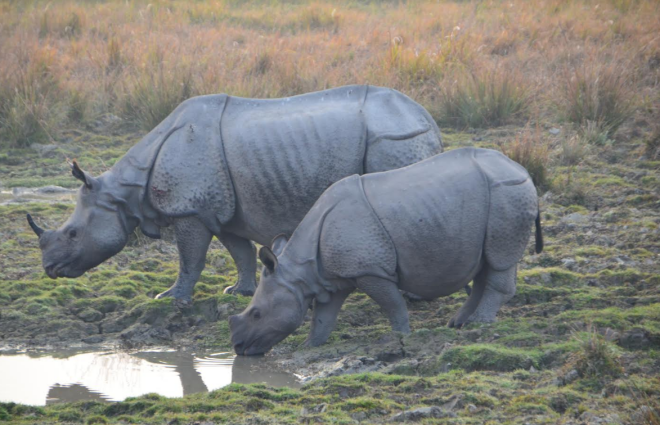Kissing the fabled Brahmaputra River in the north-eastern state of Assam, the Kaziranga National Park is home to world’s largest population of the scarce ‘one horned’ rhinoceros.
A century ago, these species were nearing extinction, mainly because of excessive poaching for the illegal horn trade. However as a result of strong animal conservation and anti-poaching programmes, the authorities have now been able to successfully increase their population, currently estimated at just over 2000.
In recognition, UNESCO in 1985 stamped the 430 square km parkland as a World Heritage step in here to see these huge creatures in their own habitat, making Assam a popular tourist destination in India.
Meaning ‘where the mountain goat has water’, Kaziranga was once an inaccessible and boggy wetland used as a hunting ground by the local tribes. In 1908, the British colonisers banned killing in the area and took measures to transform the domain as a wildlife sanctuary, today thrived by a wide variety of animal and bird life.
‘Kaziranga excites the senses, arrests the soul. It beckons a visit’. This publicised cliché inspires around 50,000 domestic and international visitors annually to the sanctuary to capture its unspoilt beauty and wildlife charms. Famous English naturalist David Attenborough and Duke and Duchess of Cambridge are among the recent ones.
According to UNESCO, it’s one of the last unmodified natural areas in the north-eastern part of India. Tall elephant grass intertwined with numerous streams and large landlocked water bodies called ‘beels’ covers most of the land, sometimes opening into rummaging grounds with shorter grass, few tall trees and bamboo thickets.

The Krabi Hills on the south western side provide a high woodland refuge for the animals during monsoon season when the lowland is submerged by the backwaters of the Brahmaputra.
Like Maasai Mara and Serengeti in Africa, Kaziranga also boasts of its own ‘Big Five’ varieties of mammals. Apart from the rhinos the others dominating the woodland are water buffalos, elephants, swamp deer, and Royal Bengal tigers.
The domain is also home to leopards, sloth bears, jungle cats, bison and langurs. Wide array of migratory and resident avian species populate the park, most common being the hornbills, pelicans, rose-ringed parakeets, serpent- eagles, red-jungle fowls, storks and cranes.
Rhinos are best spotted from the back of an elephant. An early morning ride provides a unique opportunity to sense how divinely dawn sets in the wilderness. As the first rays of the morning sun start colouring the dew drops at the edge of the tall grasses, birds sing in chorus to welcome another day.
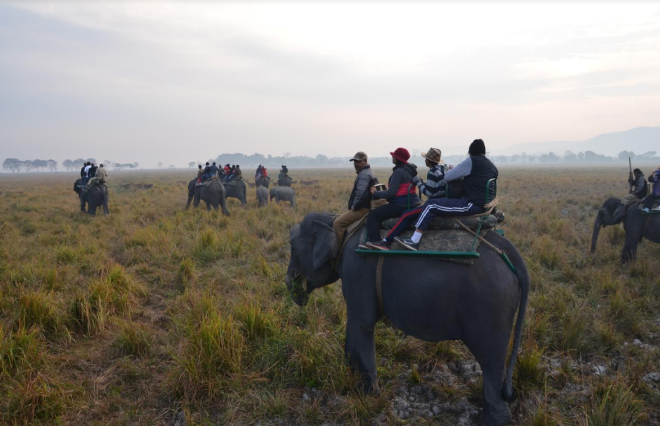
The deer clan match up the chirping of the birds with their loud calls. At times, the musical soiree is halted by the loud trumpet of an elephant or a roar from a hungry tiger. The air at that time of the day is filled with extra freshness to boost the rider’s energy level.
Alternatively safari on an open-air jeep provide much wider and deeper coverage of the forest, but then can’t get close to rhinos and buffalos.
Because of their abundance, it’s pretty easy to spot rhinos grazing in the grassland or having a dip in the muddy swamps. These grey mounds which can weigh up to even 2000 kg, display folds of skin hanging from the ridges and a comically tiny tail moving sideways. The beauty of this beast is their armour; it’s said to be bullet and sword proof, hence widely used by ancient armies for shields.
This nature’s haven also boasts the highest density of tigers among the protected areas in the world and was declared a Tiger Reserve in 2006, though chances of spotting them are low because of their hiding nature, the elevated grassland providing excellent camouflage for them to do so. However no one leaves Kaziranga without sensing their royal presence stamped everywhere by way of their pug- marks, kills and territorial markings.
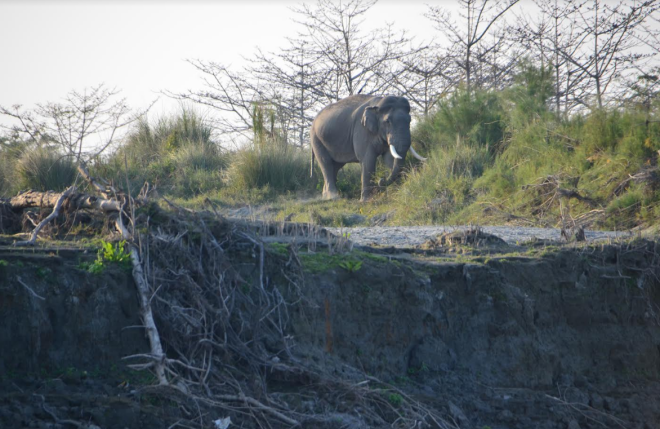
Travel Tips
Reaching there
The two nearest airports to the sanctuary are Guwahati International Airport and Jorhat Airport, located at the distance of around 217 km and 97 km respectively from the park.
Accommodation
There are several accommodation options available close to the park. Check
Safari Bookings
Check
A worthy alternative
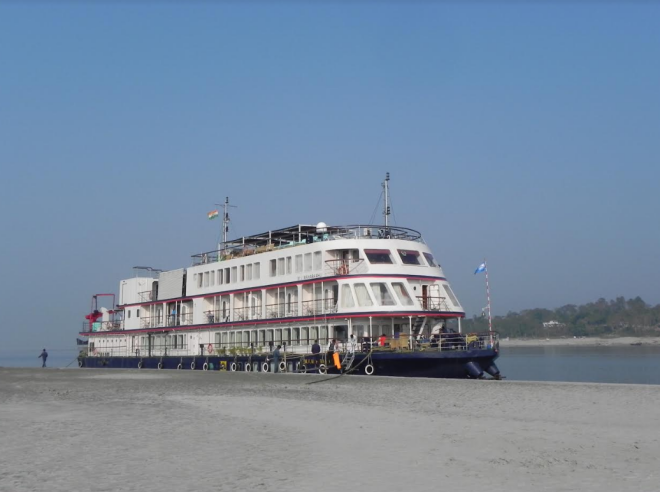
A fascinating way of including Kaziranga in any Assam itinerary is by cruising the Brahmaputra River aboard MV Mahabaahu, a luxury vessel fitted with 23 aesthetically designed cabins which includes two ‘Suites’ with balcony, two ‘Luxury Cabins with balcony, seven ‘Deluxe Cabins’ with balcony, and 12 ‘Superior Cabins’ without balcony.
All 23 cabins are air-conditioned and includes flat-screen television, satellite connections, mini-bar, telephone, electronic safe and an en-suite. Click here for details
The 7-night odyssey from Guwahati to Jorhat or in reverse direction introduces guests not only with the history, culture and people of Assam but also offers dramatic sightings of almost all of Kaziranga’s residents when sailing past the expansive forest. The cruise schedule includes both elephant and jeep safaris as land excursions, sightings of Gangetic dolphins while sailing comes in as a bonus.
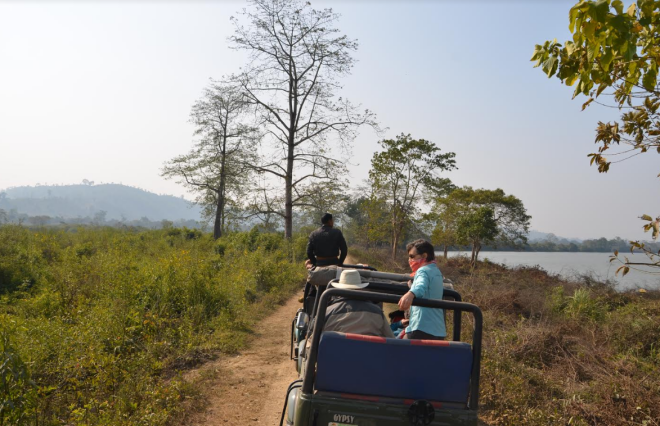
The MV Mahabaahu offers large public spaces on the open Sun deck with canopy for shade to spot a rhino, a buffalo and an elephant, some deer and even a tiger enjoying the lush river banks.
Other notable sites around Kaziranga
Not far from Kaziranga and included in the cruise itinerary are Majuli, once the world’s largest river island filled with opulent and exotic flora and fauna and Sibasagar, the ancient capital city of the Ahom dynasty packed with palaces, forts, monuments and religious shrines. Majuli lives with a rich cultural heritage and is home to many ‘satras’ or monasteries where the 15 th century Neo-Vaishnavite ideals and social reforms are still preserved in their truest forms by devout monks. The monuments at Sibasagar – Rang Ghar, Shiva Dol and Talatal Ghar are a sneak into the Tibeto-Burman Mongloid race that reigned in the region for over six centuries.

